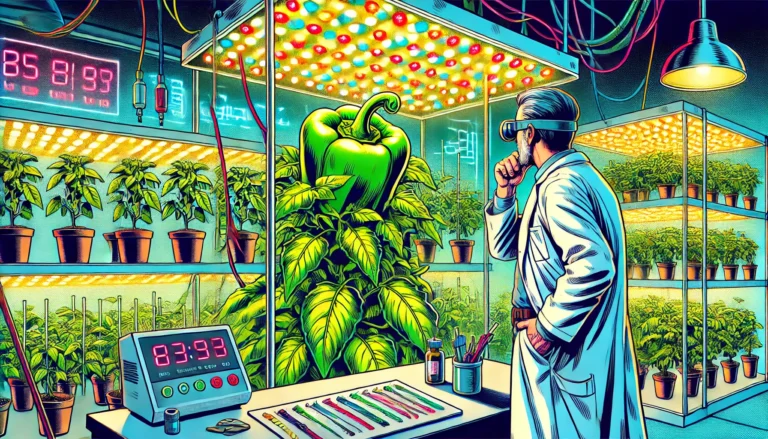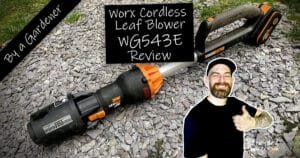Introduction
Indoor pepper growing is like bringing a slice of summer into your home all year round. It’s more than just a gardening fad—it’s about connecting with nature, even when the British weather is doing its best to keep us indoors.
Whether you’re a seasoned gardener or just fancy a crack at it, growing peppers indoors can be both a challenge and a joy. Trust me, with the right setup, your indoor peppers can be just as productive as those in any sunny garden patch.
So, grab your trowel and let’s get cracking on how to start your indoor pepper paradise.
Choosing the Best Peppers for Indoor Growing
Now, choosing the right pepper varieties is like picking the right tools for a job—get it wrong, and you’ll struggle. Some peppers just aren’t cut out for indoor life. You’ll want compact varieties that don’t mind a bit of shade and can thrive under artificial lights.
Think of chilli peppers, mini sweet peppers, or even a dwarf variety if you’re tight on space. These little troopers are ideal for indoor conditions.
Key Considerations for Choosing Pepper Varieties:
- Size and Growth Habits: Go for compact varieties that won’t turn your living room into a jungle.
- Lighting Needs: Some peppers are divas when it comes to light—make sure your grow lights are up to the task.
- Beginner-Friendly Options: If you’re new to this, stick with jalapeños or dwarf chilli peppers. They’re hardy and forgiving, perfect for cutting your teeth on.
Pepper Varieties for Indoor Growing
| Pepper Variety | Size/Height (cm) | Light Requirements | Growing Difficulty | Notes |
|---|---|---|---|---|
| Jalapeño | 60-90 | Moderate to High | Easy | Ideal for beginners, versatile use |
| Mini Sweet Peppers | 30-60 | Moderate | Easy | Compact, great for small spaces |
| Habanero | 90-120 | High | Moderate | Spicy, needs strong light |
| Cayenne | 60-90 | Moderate to High | Easy | Good for drying and powders |
| Dwarf Chilli Peppers | 20-30 | Moderate | Very Easy | Extremely compact, good for windowsills |
Setting Up Your Indoor Pepper Garden
Setting up your indoor pepper garden is a bit like building a cosy den for your plants—they need the right environment to feel at home. First off, your grow lights are non-negotiable. Natural light in the UK, especially in winter, is about as reliable as a politician’s promises.
So, invest in some good LED grow lights; they’ll keep your peppers happy and productive. If you’re unsure which lights to choose, check out my article on the Best LED Grow Lights for Indoor Gardens in 2024 for top recommendations that will give your plants the light they need to thrive.
Steps to Set Up Your Indoor Pepper Garden:
- Select Essential Equipment:
- Grow Lights: LED lights are your best mate here—energy-efficient and perfect for indoor growing.
- Containers/Pots: Make sure they drain well, or you’ll be dealing with root rot quicker than you can say “pesticide.”
- Soil Mix: A well-draining, organic-rich soil mix is the secret sauce for healthy pepper plants.
- Seedling Heat Mat: Keep your seeds toasty during germination—it’s the difference between a quick sprout and a no-show.
- Humidity Tray: This helps keep the air moist, which is crucial for young plants, especially during winter.
- Create the Ideal Growing Environment:
- Temperature: Keep it between 20-30°C. Your peppers aren’t fans of the cold.
- Humidity: Watch the humidity levels—too dry, and your plants might throw a strop.
- Maximise Space: If you’re short on space, go vertical. Shelves and multi-tiered setups can turn a small corner into a pepper powerhouse.
Indoor Pepper Growing Equipment
| Equipment | Purpose | Notes on Use |
|---|---|---|
| Grow Lights | Provide necessary light for growth | LED lights recommended for energy efficiency |
| Containers/Pots | Houses the plants and roots | Ensure good drainage; consider self-watering options |
| Soil Mix | Medium for planting | Use well-draining, organic-rich soil |
| Seedling Heat Mat | Maintain optimal germination temperature | Ideal for starting seeds in cooler climates |
| Humidity Tray | Helps maintain humidity levels | Useful for preventing issues like dry air and pests |
Steps for Successful Planting and Germination:
- Start with High-Quality Seeds: It’s worth spending a bit more to get seeds that will actually sprout.
- Prepare the Soil: Use a light, well-draining soil mix to avoid waterlogging and promote healthy growth.
- Plant the Seeds:
- Press them lightly into the soil, just enough to cover them.
- Cover with a thin layer of soil, and keep them warm and moist.
- Maintain Moisture: Keep the soil consistently moist but not soaking wet—think of it as keeping them hydrated, not drowning them.
- Use a Seedling Heat Mat: Maintain a soil temperature of 25-30°C, especially in cooler climates.
- Monitor Germination: Patience is key here. Expect to see sprouts within 7-21 days, depending on the variety.
Take your indoor gardening to the next level by learning how to maximize plant growth with LED grow lights—explore our guide on Maximizing Plant Growth with LED Grow Lights.
Caring for Your Indoor Pepper Plants
Once your pepper seedlings have sprouted, they’ll need a bit of TLC to grow into strong, productive plants. Watering is a delicate balance—too much, and you’ll end up with root rot; too little, and your plants will dry out faster than a cuppa left on the counter. Keep the top inch of soil dry before you water again.
Fertilising is equally important. Use a balanced fertiliser every couple of weeks during the growing season, and as your plants start to flower and fruit, switch to one with more potassium. This will help your peppers develop into juicy, flavourful fruits.
Pruning is also necessary to maintain a manageable size and to promote bushier growth. Regularly snip off any leggy stems to keep your plants compact and bushy, which also helps light reach all parts of the plant.
Product Recommendations:
To give your peppers the best start, here are a couple of my top picks:
Key Care Tasks for Indoor Pepper Plants:
- Watering:
- Water when the top inch of soil is dry—avoid overwatering to prevent root rot.
- Use containers with good drainage, and consider self-watering pots for ease.
- Fertilisation:
- Apply a balanced fertiliser every two weeks during the growing season.
- Switch to a potassium-rich fertiliser during fruiting to support healthy pepper development.
- Pruning:
- Regularly prune leggy stems to maintain aI apologize for the interruption. Let me continue from where we left off:
Key Care Tasks for Indoor Pepper Plants:
- Watering:
- Water when the top inch of soil is dry—avoid overwatering to prevent root rot.
- Use containers with good drainage, and consider self-watering pots for ease.
- Fertilisation:
- Apply a balanced fertiliser every two weeks during the growing season.
- Switch to a potassium-rich fertiliser during fruiting to support healthy pepper development.
- Pruning:
- Regularly prune leggy stems to maintain a compact and bushy shape.
- Remove any leaves or branches that block light from reaching the lower parts of the plant, ensuring even growth.
Dealing with Common Indoor Pepper Growing Problems
Indoor pepper growing comes with its fair share of challenges, but with a bit of know-how, you can keep your plants thriving. Overwatering is a common pitfall—too much water can lead to yellowing leaves and root rot. On the flip side, insufficient light can cause your plants to become leggy, with spindly growth and poor fruit production. If you spot pests like aphids or spider mites, don’t panic. There are plenty of organic solutions, like neem oil or introducing beneficial insects.
Common Indoor Pepper Growing Issues:
- Overwatering: Can cause yellowing leaves and root rot. To prevent this, water less frequently and ensure your pots have proper drainage.
- Insufficient Light: Leads to leggy growth and poor fruit production. Increase light exposure by using full-spectrum grow lights or moving plants closer to the light source.
- Pests: Aphids, spider mites, and whiteflies are common pests indoors. Combat them with organic insecticides or by introducing natural predators like ladybirds.
- Diseases: Powdery mildew and nutrient deficiencies can hinder growth. Ensure good air circulation, avoid overwatering, and fertilise regularly.
Common Indoor Pepper Growing Problems and Solutions
| Problem | Symptoms | Solution |
|---|---|---|
| Overwatering | Yellowing leaves, root rot | Water less frequently, ensure proper drainage |
| Insufficient Light | Leggy growth, poor fruit production | Increase light exposure, use full-spectrum grow lights |
| Pests (e.g., aphids) | Visible insects, sticky residue | Use organic insecticides or introduce natural predators |
| Powdery Mildew | White powder on leaves | Improve air circulation, reduce humidity |
| Nutrient Deficiency | Yellowing, slow growth | Fertilise regularly with a balanced, phosphorus-rich fertiliser |
FAQ: Common Questions About Indoor Pepper Growing
Q1: How much light do indoor pepper plants need?
A: Indoor pepper plants need plenty of light to thrive. Here’s what you should consider:
- Ideal light: 12-16 hours per day.
- Best option: LED grow lights for full-spectrum light.
- Natural light: Place near a south-facing window.
- Supplement: Use grow lights in winter or low-light environments.
Q2: How do I pollinate indoor pepper plants?
A: While peppers are self-pollinating, you may need to assist the process indoors:
- Self-pollinating plants: Shake gently to distribute pollen.
- Manual pollination: Use a small paintbrush or cotton swab.
- Importance: Especially necessary if you notice poor fruit set despite flowering.
Q3: What is the best temperature for growing peppers indoors?
A: Peppers grow best in warm conditions. Keep these temperature tips in mind:
- Daytime temperature: 20-30°C (68-86°F).
- Nighttime minimum: No lower than 18°C (65°F).
- Tips: Use a heat mat during germination; avoid cold drafts.
Q4: How often should I fertilize my indoor pepper plants?
A: Regular fertilisation is key to healthy growth. Here’s how to manage it:
- Frequency: Every two weeks during the growing season.
- Transition: Switch to higher potassium fertiliser during fruiting.
- Caution: Avoid over-fertilisation; consider organic options for a steady nutrient release.
Q5: How do I prevent pests on indoor pepper plants?
A: Keeping pests at bay is crucial for indoor pepper plants. Follow these steps:
- Cleanliness: Regularly wipe leaves to remove dust and debris.
- Pest control: Introduce beneficial insects like ladybirds; use organic insecticides (e.g., neem oil).
- Prevention: Ensure good air circulation to deter pests and reduce fungal risks.
Harvesting and Enjoying Your Peppers
Harvesting your peppers is like reaping the rewards of your hard work. Knowing when and how to harvest can make all the difference in taste and shelf life. Peppers can be picked at different stages of ripeness—green peppers offer a more bitter, tangy flavour, while fully ripened red, orange, or yellow peppers are sweeter and juicier. When you’re ready to harvest, use sharp scissors or pruning shears to cut the peppers from the plant, ensuring you leave a small portion of the stem attached to avoid damaging the fruit.
For peppers and other flowering crops, learning how to pollinate indoor vegetables by hand can make a big difference to your harvest — see our complete pollination guide.
Steps to Harvest Peppers:
- Determine Ripeness: Harvest peppers when they reach the desired color and size.
- Use Proper Tools: Use sharp scissors or pruning shears to cut the peppers from the plant, leaving a small portion of the stem attached.
- Post-Harvest Care:
- Store in a cool, dry place.
- Preserve by drying, freezing, or pickling to enjoy your harvest longer.





